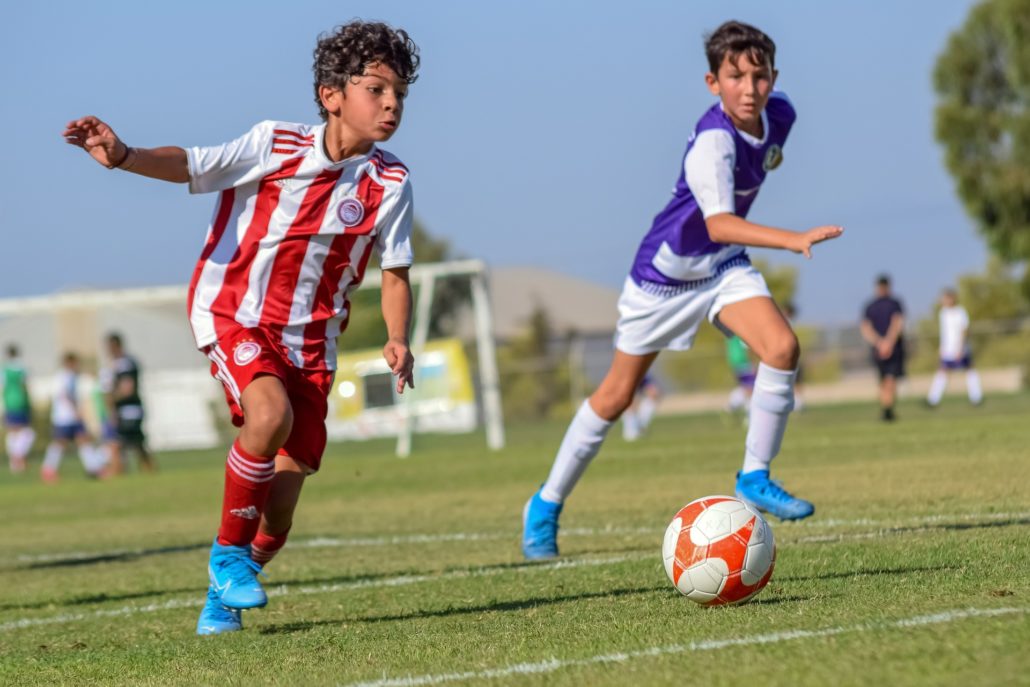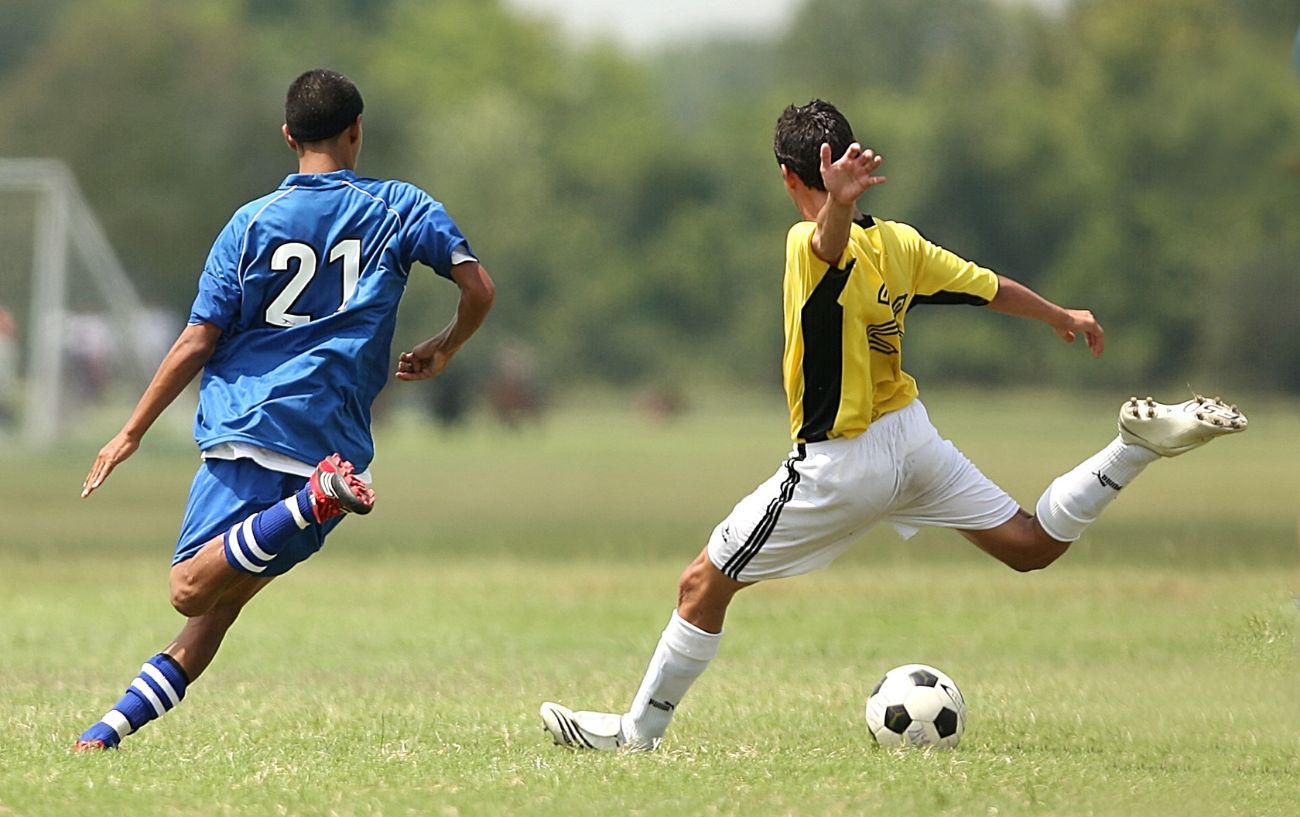Soccer players run an average of seven miles in a game. This includes a combination of sprinting, running, jogging, and walking.
This distance covers the physical demands placed on the players throughout the match.
How Far Do Soccer Players Run In A Game?
Soccer players cover an average distance of around seven miles per game, which includes a mix of sprinting, running, jogging, and walking. This makes soccer one of the sports where players run the most.
Have you ever wondered how far soccer players run during a game? Soccer is known for its fast-paced nature, with players constantly moving across the field. In this blog post, we will explore the average distance covered by soccer players in a game and the physical demands placed on these athletes.
Average Distance Covered:
- On average, a soccer player will cover approximately seven miles per match. This includes a combination of sprinting, running, jogging, and walking.
- The distance covered can vary depending on position and playing style. Midfielders and forwards tend to cover more ground compared to defenders.
- It’s important to note that this distance can change depending on the level of play and the intensity of the game.
Physical Demands:
- Soccer is a physically demanding sport that requires endurance, agility, and speed.
- Players are constantly on the move, making quick sprints, changing directions, and engaging in tactical movements.
- The high-intensity nature of the game requires players to have a good cardiovascular fitness level.
- The distance covered by soccer players highlights the athleticism and stamina required to compete at the highest level.
Factors Affecting Distance Covered:
- Playing time: The longer a player stays on the field, the more distance they are likely to cover.
- Tactical positioning: Players in certain positions might be required to cover more ground depending on their team’s strategy.
- Game tempo: The pace of the game can influence the distance covered, with faster games resulting in more running.
Soccer players cover a significant distance during a game, with an average of around seven miles. This highlights the physical demands and endurance required to excel in the sport. Understanding the distance covered by players can give you a deeper appreciation for their athleticism and the level of fitness needed to compete at the professional level.
How Far Do English Premier League (epl) Soccer Players Run In A Game?
English Premier League (EPL) soccer players run an average of seven miles per game. This includes a mix of sprinting, running, jogging, and walking throughout the match.
The English Premier League (EPL) is known for its fast-paced and physically demanding style of play. Soccer players in the EPL cover an impressive distance during a single game. Here’s a breakdown of how far they run:
- The average distance covered by an English Premier League player in a game is around 10-11 kilometers (6.2-6.8 miles).
- The distance covered can vary depending on factors such as playing positions, tactical approach, and individual playing styles.
- Midfielders tend to cover the most ground, running around 11.5-13 kilometers (7.1-8.1 miles) per game on average.
- Forwards and wingers also cover a significant distance, usually around 10-11 kilometers (6.2-6.8 miles).
- Defenders typically cover a slightly shorter distance, averaging around 9.5-10.5 kilometers (5.9-6.5 miles).
- Goalkeepers cover the least distance due to their role being primarily focused on positioning and shot-stopping, covering around 3-4 kilometers (1.9-2.5 miles).
It’s important to note that these distances include a combination of activities such as sprinting, running, jogging, and walking throughout the game. Soccer players require a high level of endurance to maintain their performance levels throughout the match.
Overall, English Premier League soccer players cover impressive distances during a game, showcasing their athleticism and commitment to the sport.
How Far Do Soccer Goalkeepers Run?
In a soccer game, players typically cover an average distance of seven miles. This includes a combination of sprinting, running, jogging, and walking throughout the match.
Soccer goalkeepers may not cover as much ground as outfield players, but they are still an essential part of the game. Here are some key points about how far soccer goalkeepers typically run during a game:
- Goalkeepers tend to cover less distance compared to outfield players, as their main role is to guard the goal and make saves.
- On average, goalkeepers will run around 2 to 3 miles per game, depending on the match dynamics.
- The distance covered by goalkeepers can vary depending on factors such as the style of play, the number of shots on goal, and the number of high balls they have to deal with.
- Goalkeepers also engage in additional activities during the game, such as organizing their defense, communicating with teammates, and distributing the ball after making a save.
While goalkeepers may not run as much as their teammates on the field, they still play a crucial role in the game. Their focus is primarily on positioning themselves effectively and making critical saves to keep their team in the match.
How Far Do Soccer Defenders Run In A Game?
Soccer players cover an average of seven miles per game, which includes a mix of sprinting, running, jogging, and walking. This physically demanding sport requires players to put in a significant amount of distance throughout a match.
Soccer defenders play a crucial role in the game, ensuring that their team prevents the opposition from scoring goals. Defenders are expected to cover a significant distance during a game, both in terms of high-speed sprints and constant movement on the field.
Here’s a breakdown of how far soccer defenders typically run in a game:
- Defenders cover an average distance of around 7-8 miles per game.
- This distance includes a combination of fast sprints, running, jogging, and walking.
- On average, defenders can sprint for a total distance of 800-1000 meters during a match.
- They also engage in constant movement and changing positions to communicate with teammates and maintain defensive organization.
Defenders not only focus on covering ground but also play a vital role in intercepting passes, making tackles, and marking opponents. Their defensive efforts contribute significantly to the overall performance of the team.
How Far Do Soccer Players Run In A World Cup?
In a World Cup game, soccer players run an estimated seven miles, which includes a combination of sprinting, running, jogging, and walking. Referees often cover even more distance during a match.
Soccer is known for its fast-paced and physically demanding nature. During a World Cup match, soccer players cover a considerable distance on the field. Here’s a breakdown of how far they typically run:
- On average, soccer players run an estimated seven miles per game during the World Cup.
- This distance includes a combination of sprinting, running, jogging, and walking.
- The intense physical demands of the game require players to cover such a significant distance.
- It’s essential to note that this distance may vary depending on the position of the player and their playing style.
- Midfielders and forwards tend to cover more ground due to their involvement in both attacking and defensive actions.
- Defenders generally cover slightly less distance because they prioritize maintaining defensive positions.
- Goalkeepers have a more localized role, which means they cover the least distance compared to outfield players.
- Keep in mind that these figures are just averages, and individual performances may differ.
Overall, soccer players in the World Cup showcase remarkable endurance and athleticism as they tirelessly cover a considerable amount of ground throughout the course of a game.
How Far Do Soccer Midfielders Run In A Game?
Soccer midfielders cover an average distance of seven miles per game. This includes a mix of sprinting, running, jogging, and walking throughout the match.
Soccer midfielders have one of the most physically demanding positions on the field. They are expected to cover a significant amount of ground, contributing both defensively and in the attack. Here is an overview of how far soccer midfielders typically run in a game:
- Average Distance Covered: Midfielders are often the engine room of the team, constantly moving and providing support to both the defense and the attack. On average, a soccer midfielder will cover around 9 to 11 kilometers per game.
- High-Intensity Runs: Midfielders are required to make frequent sprints and explosive runs to win the ball, create chances, and support their teammates. They typically make around 10 to 12 high-intensity runs per game, covering distances of more than 20 meters at high speeds.
- Defensive Workrate: Midfielders also play a crucial role in defensive duties, pressing the opposition, and helping to win back possession. They cover a considerable distance while chasing and blocking opponents, often totaling around 4 to 6 kilometers per game.
- Offensive Contributions: In addition to their defensive responsibilities, midfielders are expected to contribute to the team’s attack. They make runs into the opposition’s half, create scoring opportunities, and support the forwards. This offensive effort can add up to around 3 to 5 kilometers per game.
- Tactical Factors: The distances covered by midfielders can vary depending on the tactics employed by the team and the specific style of play. Some teams may require their midfielders to have even higher work rates, resulting in greater distances covered.
Overall, soccer midfielders are some of the hardest working players on the field, covering a significant distance during a game. Their versatility and ability to contribute both offensively and defensively make them an essential component of a successful team.
For more information on the physical demands of soccer and the distances covered by players in other positions, refer to the sections below.
—
Physical Demands On Soccer Players:
Soccer is a demanding sport that requires players to have high levels of fitness and endurance. The physical demands placed on soccer players are influenced by various factors, including position, playing style, and the intensity of the game. Here are some key points to consider:
- Positions and Distances Covered: Different positions in soccer require different levels of physical exertion. For example, midfielders, as discussed earlier, cover more ground compared to players in other positions. Defenders and forwards also have their own physical demands, depending on their roles within the team.
- Sprinting and Acceleration: Soccer is not just about running long distances but also about quick bursts of speed. Players need to be able to sprint and accelerate to beat opponents, chase down loose balls, or make a crucial tackle.
- Endurance and Stamina: Soccer matches can last for 90 minutes or longer, depending on stoppage time. Players need to have high levels of endurance and stamina to maintain their performance throughout the game.
- Change of Direction: Soccer players also need to be agile and able to change direction quickly. They often make sharp turns, perform feints, and change their running patterns to navigate through the opposition’s defense or to quickly adjust to the movements of their teammates.
- Training and Physical Preparation: To meet these physical demands, soccer players undergo rigorous training programs that focus on aerobic fitness, strength, agility, and speed. This training helps them develop the necessary physical attributes to perform at a high level and reduce the risk of injuries.
Understanding the physical demands of soccer provides valuable insights into the preparation and conditioning required for players to excel in the sport.
—
By providing information on the distances covered by soccer midfielders and the physical demands of the sport, this section sheds light on the work rate and endurance required to excel in the midfield position. Understanding these aspects helps players, coaches, and fans appreciate the athleticism and contribution of these key players on the field.
Fifa Records For Running Soccer Players
Soccer players cover an average distance of seven miles per game, incorporating sprinting, running, jogging, and walking. This physical demand is significantly higher during the World Cup.
Soccer players are known for their incredible athleticism and endurance on the field. The distance they cover during a game is truly impressive. FIFA, the international governing body for soccer, keeps records of the distances covered by players in major tournaments.
Here are some notable FIFA records for running soccer players:
- World Cup Record: In the FIFA World Cup, players run an estimated average of seven miles per game. This includes a combination of sprinting, running, jogging, and walking. It’s important to note that the distance covered can vary depending on various factors, including playing position and playing style.
- Speed Record: The fastest recorded sprint by a soccer player during a FIFA World Cup game was achieved by Arjen Robben of the Netherlands in 2014. He reached a top speed of 37.0 km/h (22.99 mph) during a match against Spain.
- Ironman Award: The Ironman Award is given to the player who covers the most distance during a FIFA World Cup tournament. The record is held by Mile Jedinak of Australia, who covered a total distance of 62.17 miles (99.99 km) in the 2018 World Cup.
- Top Distance Covered: The player who has covered the most distance in a single game during a FIFA World Cup is Thomas Meunier of Belgium. He ran a total of 9.82 miles (15.8 km) in a match against England in 2018.
- Average Distance: On average, a soccer player will cover approximately seven miles per match. This figure takes into account the varying roles and positions played by different players on the field.
These impressive records highlight the incredible physical demands placed on soccer players during a game. The combination of speed, agility, and endurance required is truly remarkable. Whether it’s running towards the goal or tracking back to defend, soccer players constantly push themselves to their limits on the field.
Soccer players are true athletes who cover significant distances during a game. The FIFA records for running soccer players demonstrate the level of physical endurance and dedication required to excel in the sport. From sprinting to walking, these players showcase their exceptional athleticism every time they step onto the field.
Soccer Players Waiting With Bursts Of Pace
Soccer players exhibit bursts of pace while waiting, running an average of seven miles per game, including sprinting, running, jogging, and walking. Their physical demands are high, requiring endurance and agility.
Soccer is a fast-paced and physically demanding sport that requires athletes to be in peak condition. One of the key aspects of the game is the ability to wait patiently for the right moment to make a decisive move. Soccer players often exhibit bursts of pace when they are waiting for the ball or positioning themselves on the field.
This allows them to quickly react and make explosive runs when the opportunity arises.
Here are some key points to understand about soccer players waiting with bursts of pace:
- Quick bursts: Soccer players are constantly on the move, even when waiting for the ball. They employ short bursts of speed to quickly change positions or close down opposing players.
- Reactive movements: In soccer, anticipation is crucial. Players must be able to read the game and react instantly to the movements of their teammates and opponents. This requires the ability to accelerate rapidly when necessary.
- Strategic positioning: While waiting for the ball, soccer players strategically position themselves to create passing lanes or to be in a favorable position to receive the ball. These positions are often determined by the player’s anticipation of the play and their awareness of their teammates’ positions.
- Off-the-ball runs: Soccer players also make runs off the ball to create space for teammates or to confuse the opposing defense. These runs often involve quick bursts of pace to catch defenders off guard.
Soccer players waiting with bursts of pace are an integral part of the game, adding excitement and unpredictability to the sport. Their ability to quickly accelerate and react to the game’s dynamic nature sets them apart as exceptional athletes on the field.
Increase Running Distance And Stamina
Soccer players run an average of seven miles per game, including a combination of sprinting, running, jogging, and walking. This physical demand showcases their stamina and endurance on the field.
:
Soccer is a high-intensity sport that requires players to have excellent stamina and the ability to cover long distances during a game. To maximize your running distance and improve your overall stamina, here are some tips:
- Interval Training: Incorporate interval training into your workout routine. This involves alternating between bursts of high-intensity running and periods of active recovery. Interval training is proven to increase running distance and improve overall endurance.
- Long Distance Runs: Regularly engage in long-distance runs to gradually increase your running distance. Start with shorter distances and gradually build up to longer runs. This will help condition your body to handle longer distances during a game.
- Cross Training: Include cross-training exercises, such as cycling or swimming, in your training regimen. These activities work different muscles and improve cardiovascular fitness, ultimately enhancing your running distance and stamina.
- Strength Training: Don’t neglect strength training exercises. Strengthening your muscles, especially your legs, will provide the power and endurance needed to cover more ground during a game.
- Proper Nutrition: Fuel your body with a balanced diet that includes carbohydrates, proteins, and healthy fats. Consuming the right nutrients will optimize your energy levels and support long-distance running.
- Rest and Recovery: Allow your body time to rest and recover between intense training sessions. Adequate rest is vital for muscle repair and growth, which will ultimately improve your running distance and stamina.
- Consistency: Consistently follow your training routine to see improvements in your running distance and overall stamina. Consistency is key when it comes to increasing endurance.
By incorporating these tips into your training routine, you will gradually build up your running distance and stamina, helping you perform better on the soccer field. Remember, consistency and proper training techniques are crucial for long-term success.
Player’s Mobility And Distance Covered
Soccer players, including those in World Cup matches, cover approximately seven miles per game, with a mix of sprinting, running, jogging, and walking. This level of mobility highlights the physical demands placed on these athletes during each match.
:
Soccer players are known for their exceptional mobility and incredible stamina. They cover a significant distance during a game, incorporating a combination of sprinting, running, jogging, and walking. Here’s a breakdown of the player’s mobility and the average distance covered in a soccer match:
- Sprinting: Soccer players sprint in short bursts, typically during quick runs towards the goal or when attempting to outrun opponents. These explosive sprints help them create scoring opportunities or chase down loose balls.
- Running: Running is a fundamental component of a soccer player’s movement. They maintain a steady pace as they navigate the field, keeping up with the flow of the game and positioning themselves strategically.
- Jogging: Jogging allows soccer players to conserve energy while still staying actively engaged in the game. They may jog when the pace of the match slows down or during moments of transition between offensive and defensive plays.
- Walking: Though less frequent, soccer players do walk during a game. Walking occurs during slower phases of the match, such as when the ball is out of play or when teammates are repositioning.
Now, let’s take a look at the distance covered by soccer players during a typical game:
- On average, a soccer player covers approximately seven miles per match. This distance may vary depending on factors such as player position, team strategy, and the intensity of the game.
- Midfielders tend to cover the most distance among all players, as they are involved in both offensive and defensive aspects of the game. They are responsible for transitioning the ball from defense to attack and vice versa.
- Defenders also cover a considerable distance, especially when they make overlapping runs to support the offensive plays or when they engage in high-intensity duels with opponents.
- Strikers and forwards cover a slightly lesser distance compared to midfielders and defenders, as their primary focus is on creating scoring opportunities and making quick bursts towards the opponents’ goal.
- Goalkeepers, while not covering as much ground as outfield players, still move within their designated area to anticipate and block shots.
The distance covered by soccer players in a game demonstrates their immense physicality and showcases the demanding nature of the sport. Their constant movement and endurance are vital to their overall performance on the field.
Captains Running More In Soccer
In soccer, players run an average of seven miles per game, including a mix of sprinting, running, jogging, and walking. This makes it one of the sports where players cover the most distance on the field.
Captains in soccer often have a higher workload and run more than their teammates. Here’s why:
- Leadership responsibilities: Captains are not only responsible for their own performance but also for guiding and motivating their teammates. This requires them to constantly communicate and provide instructions, which results in more running on the field.
- Organizing the team: Captains need to organize the team’s positioning, set plays, and coordinate tactics during the game. This strategic role requires them to cover more ground to ensure they can effectively direct their teammates.
- Covering for teammates: Captains often take on the responsibility of covering for their teammates when they are out of position or during defensive transitions. This requires extra running to fill gaps and protect the team’s defensive structure.
- Leading by example: As leaders, captains are expected to set the tone with their work rate and effort. They inspire their teammates through their actions, often pushing themselves to run even more to set a positive example for the rest of the team.
- Communicating with referees: Captains are also the primary point of contact between the team and the referees. They engage in discussions, voice concerns, and provide feedback, which requires additional running to constantly be in close proximity to the referees.
The role of a captain in soccer is demanding both in terms of leadership responsibilities and on-field performance. They lead by example, organize the team, cover for teammates, and communicate with both teammates and referees, resulting in them running more during a game compared to other players.
How Fast Do Soccer Players Run?
Soccer players cover an average of seven miles per game, which includes a combination of sprinting, running, jogging, and walking. They endure physically demanding matches, with referees running even more.
Soccer is known for its fast-paced gameplay, which requires players to have exceptional speed and agility. Here are some key points on how fast soccer players run:
- Sprinting speed: Soccer players can reach impressive speeds during sprints, often averaging around 20 miles per hour.
- Burst speed: In short bursts, players can reach even higher speeds, sometimes exceeding 25 miles per hour.
- Rapid acceleration: Soccer players are trained to quickly accelerate from a standing position, allowing them to beat opponents to the ball.
- Quick changes of direction: Along with their speed, soccer players also possess the ability to change direction rapidly, which adds to their effectiveness on the field.
Soccer players showcase remarkable speed on the pitch, whether it’s sprinting, accelerating, or changing directions. Their agility and speed contribute to their ability to outmaneuver opponents and make impactful plays during the game.
Factors Influencing Speed
Several factors affect how fast soccer players can run during a game. These include:
- Individual fitness: Players with higher fitness levels tend to have greater speed and endurance.
- Position on the field: Different positions require varying levels of speed. Forwards and wingers often prioritize speed, while defenders may focus more on positioning and agility.
- Personal attributes: Each player’s genetic makeup and physical attributes play a role in their speed potential.
- Playing surface: The condition of the field can affect a player’s speed and agility.
It’s important to note that while speed is advantageous in soccer, it’s not the sole determining factor for success. Technical skills, decision-making, and teamwork also contribute significantly to a player’s overall performance.
Tracking Speed
To accurately measure a player’s speed during a game, specific tracking technologies are utilized. These include:
- GPS tracking devices: Many professional soccer teams use GPS devices to monitor their players’ performance metrics, including speed.
- Video analysis: Coaches and analysts review game footage to assess players’ speed and movement patterns.
- Speed sensors: Some soccer stadiums are equipped with sensors that measure the speed of players as they move across the field.
These tracking methods help teams assess a player’s performance, make strategic decisions, and develop training plans that address areas for improvement.
Speed is a crucial aspect of soccer player performance, allowing them to make explosive sprints, outpace opponents, and create game-changing plays. Factors like individual fitness, position, personal attributes, and playing surface all influence a player’s speed. By tracking and analyzing speed metrics, teams can optimize training and enhance player performance on the field.
So the next time you watch a soccer match, pay attention to the incredible speed and agility displayed by the players.

Credit: barcelonapremiersc.com
Frequently Asked Questions On How Far Do Soccer Players Run In A Game?
How Many Miles Do You Run Per Soccer Game?
Soccer players run approximately seven miles per game, including sprinting, running, jogging, and walking.
How Many Miles Do You Run In A Football Game?
In a football game, players run approximately seven miles on average, including a mix of sprinting, running, jogging, and walking. This distance may vary depending on factors such as the player’s position and playing style.
How Many Miles Do World Cup Players Run In A Game?
World Cup players run an estimated seven miles per game, including sprinting, running, jogging, and walking.
How Much Messi Runs In A Match?
On average, Messi runs approximately seven miles in a match, including sprinting, running, jogging, and walking.
Conclusion
Soccer players cover an average of seven miles per game, incorporating various levels of intensity such as sprinting, running, jogging, and walking. This shows the incredible physical demands placed on these athletes. The distance covered highlights the stamina, endurance, and athleticism required to excel in the sport.
So the next time you watch a soccer match, appreciate the immense effort put in by the players as they tirelessly navigate the field, running both physically and metaphorically to pursue victory.

General Manager & Auditorial Head.
Killian Jake is a World Sports Traveler and hobbyist sports lover. By exploring different sorts of playing modules like indoor, outdoor, and many more. As for professionalism and writing, it’s helpful to give you the right suggestions on different games and sports.





